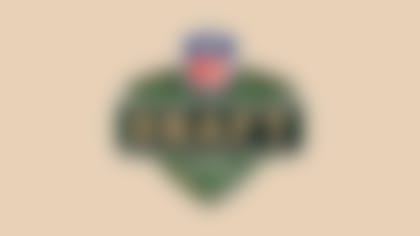While there is rarely anything brand new introduced to the game of football, the NFL game is cyclical and concepts can re-emerge to become a fashionable mode of play.
The no-huddle offense appears to be making a comeback.
The term "no-huddle" is a bit misleading when you attempt to break down what is really going on in the modern game. It is more of a "muddle huddle," which means the offensive players line up in a formation as soon as the ball is placed down by the official and the quarterback then surveys the defense. Rather than spending 25 seconds in a huddle, the offensive players spend that time at the line of scrimmage. It can be time well spent, but it also comes with issues.
Three years ago, I wrote a feature article for the Super Bowl program that was a look into the future of football. Among a number of concepts I thought would change the game was the idea of eliminating the standard huddle. Does it make sense for an offense to gather 60 times a game 7 yards behind the line of scrimmage and discuss the next play? Not really. The offense still walks to the line of scrimmage with no idea as to what the defense has in store.
Audibles are a mechanism to change the play at the line and are often used by a quarterback when the defense is not in the alignment predicted in the huddle. Many teams also incorporate a "check-with-me" offense, which basically informs players that the play call will be made at the line of scrimmage rather than in the huddle.
Why use a "check-with-me" or audible offensive system? Because the quarterback will make a better choice after seeing the defensive alignment.
So, why waste time behind the closed door known as the huddle when that time can be spent diagnosing the defense? While the huddle may never be completely eliminated from the game, the no-huddle is a growing trend that more teams are using.
While the Buffalo Bills ran the no-huddle offense throughout their Monday night loss to New England, five other teams –- Cincinnati, Atlanta, Indianapolis, New England, and Pittsburgh -- ran it in Week 1 as a change-of-pace to either rattle the opposing defense or to energize their own team.
I have talked with former Bengals quarterback Boomer Esiason on a number of occasions to discuss the no-huddle package Cincinnati made famous in the late '80s under Sam Wyche. Esiason was a very bright player with total control of the offense without the help of the electronic communication devices quarterbacks use today.
The Bengals also incorporated a hurry-up offense that was an extension of the no-huddle it used when opposing defenses were caught in the wrong personnel groups and the offense had a distinct tactical advantage. The league then stepped in and changed the rules to give defenses a chance to substitute players if the offense substituted. That was a critical change to the no-huddle philosophy.
Then, along came the Buffalo Bills' "K-Gun" offense of the '90s. I was on the New York Jets' defensive staff when Jim Kelly and his no-huddle helped lead the Bills to four consecutive Super Bowl appearances. The Bills rarely changed personnel groupings, oftentimes playing with one running back, one tight end and three wide receivers. They didn't use a lot of different plays but were very interested in making opposing defenses line up before deciding which play would beat the look the defense presented. Since the Bills spent so much time in the no-huddle package, they were built to use their base offense as a two-minute package at any time.
The 2009 edition of the Bills decided to take a page from its glorious past and recommit to the no-huddle. Despite the fact that the Bills had three offensive linemen with no professionl experience heading into the season opener in New England, Buffalo nearly knocked off the Patriots. The "muddle huddle" that the Bills used got Vince Wilfork for a penalty, but it also got the Bills in two illegal-formation penalties, a false start and a holding call. One former NFL coach said the Bills will iron out the problems, but the best thing about the Buffalo no-huddle is Terrell Owens can't work his quarterback like he can in a huddle.
He wasn't kidding.
The Bills are not alone in employing a "muddle huddle" / no-huddle / hurry-up package. The Falcons let Matt Ryan use it last season as a rookie, and will build on the package this year. Carson Palmer, Peyton Manning, Tom Brady and Ben Roethlisberger all threaten opposing defenses with the package.
When a team possesses a field general such as the ones mentioned, it is smart football to install elements of a no-huddle approach. Last week, Roethlisberger used a no-huddle 10 times late in the Steelers' season-opening win over the Titans, completing all four of his passes and taking one sack. In overtime, Roethlisberger hit his first three passes in a no-huddle offense to set up the winning field goal.
Here are five things I like about the no-huddle offense:
1. It lets the quarterback identify the defense.
2. It can wear out a pass rush that has to get in their stance early.
3. It can reduce what a team's defense can have on its call sheet.
4. It is excellent preparation for two-minute drills.
5. It puts the game more in the hands of the quarterback.
Here are five negative aspects of the no-huddle offense:
1. Teams can't use the quick count without a play called before the players line up.
2. Offensive players, especially receivers, can get fatigued.
3. Inexperienced players can't get the help veterans provide in the huddle with assignments.
4. It's tough on the road, where crowd noise is a big factor.
5. It can be a reduced package for the offense, making quarterback calls easier to identify for the defense.
Variations of the no-huddle offense are going to continue to grow in the NFL. It should provide the opportunity for more plays per game. If a team has a smart quarterback, there is a rhythm that develops in this environment that is advantageous for offenses.
However, I do worry about any acceleration in play-calling that might cause a three-and-out series to take just more than a minute and send a tired defense back on the field. Watch this week when a team goes to a no-huddle offense and see how much time the quarterback takes to set up his players, read the defense and snap the ball.



